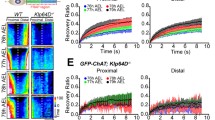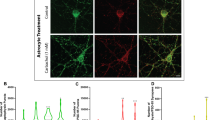Abstract
Cholinesterases present homologies with some cell adhesion molecules; however, it is unclear whether and how they perform adhesive functions. Here, we provide the first direct evidence showing that neurite growth in vitro from various neuronal tissues of the chick embryo can be modified by some, but not all, anticholinesterase agents. By quantifying the neuritic G4 antigen in tectal cell cultures, the effect of anticholinesterases on neurite growth is directly compared with their cholinesterase inhibitory action. BW 284C51 and ethopropazine, inhibiting acetylcholinesterase (AChE) and butyrylcholinesterase (BChE), respectively, strongly decrease neurite growth in a dose-dependent manner. However, echothiophate which inhibits both cholinesterases, does not change neuritic growth. These quantitative data are supplemented by morphological observations in retinal explant cultures grown on striped laminin carpets, viz., defasciculation of neurite bundles by BW 284C51 and Bambuterol occurs, indicating that these drugs disturb adhesive mechanisms. These data strongly suggest that a) cholinesterases can participate in regulating axonal growth, b) both AChE and BChE can perform such a nonsynaptic function, and c) this function is not the result of the enzyme activity per se, since at least one drug was found that inhibits all cholinesterase activities but not neurite growth. Thus, a secondary site on cholinesterase molecules must be responsible for adhesive functions.
Similar content being viewed by others
References
Barthalay Y, Hipeau-Jacquotte R, De la Escalera S, Jimenez F, Piovant M (1990) Drosophila neurotactin mediates heterophilic cell adhesion. EMBO J 9:3603–3609
Bon S, Méflah K, Musset F, Grassi J, Massoulié J (1987) An immunoglobulin M monoclonal antibody, recognizing a subset of acetylcholinesterase molecules from electric organ of Electrophorus and Torpedo, belongs to the HNK-1 anti-carbohydrate family. J Neurochem 49:1720–1731
Bottenstein E, Sato GH (1979) Growth of a rat neuroblastoma cell line in serum-free supplemented medium. Proc Natl Acad Sci USA 76:514–517
Chatonnet A, Lockridge O (1989) Comparison of butyrylcholinesterase and acetylcholinesterase. Biochem J 260:625–634
Cole GJ, Schachner M (1987) Localization of the L2 monoclonal antibody binding site on chicken neural cell adhesion molecule (NCAM) and evidence for its role in NCAM-mediated cell adhesion. Neurosci Lett 78:227–232
De la Escalera S, Bockamp EO, Moya F, Piovant M, Jimenez F (1990) Characterization and gene cloning of neurotactin, a Drosophila transmembrane protein related to cholinesterases. EMBO J:3603–3609
Dodd J, Morton SB, Karagogeos D, Yamamoto M, Jessell TM (1988) Spatial regulation of axonal glycoprotein expression on subsets of embryonic spinal neurons. Neuron 1:105–116
Drews U (1975) Cholinesterase in embryonic development. Prog Histochem Cytochem 7:1–53
Ellman GL, Courtney DK, Anders V, Featherstone RM (1961) A new and rapid colorimetric determination of acetylcholinesterase activity. Biochem Pharmacol 7:88–95
Halfter W, Newgreen DF, Sauter J, Schwarz U (1983) Oriented axon outgrowth from avian embryonic retinae in culture. Dev Biol 95:56–64
Haninec P, Dubovy P (1992) Origin of cells in contact with the growth cones of embryonal peripheral nerves and histochemical detection of nonspecific cholinesterase activity in quail-chick and chick-quail chimeras. J Neurosci Res 31:301–308
Hucho F, Järv J, Weise C (1991) Substrate-binding sites in acetylcholinesterase. Trends Pharmacol Sci 12:422–426
Koelle WA, Koelle GB, Smyrl EG (1976) Effects of persistent selective suppression of ganglionic butyrylcholinesterase on steadystate and regenerating levels of acetylcholinesterase: implications regarding function of butyrylcholinesterase and regulation of protein synthesis. Proc Natl Acad Sci USA 73:2936–2938
Krejci E, Duval N, Chatonnet A, Vincens P, Massoulié J (1991) Cholinesterase-like domains in enzymes and structural proteins: functional and evolutionary relationships and identification of a catalytically essential aspartic acid. Proc Natl Acad Sci USA 88:6647–6651
Kruse J, Mailhammer R, Wernecke H, Faissner A, Sommer I, Goridis C, Schachner M (1984) Neural cell adhesion molecules and myelin-associated glycoprotein share a common moiety recognized by monoclonal antibodies to L2 and HNK-1. Nature 311:153–155
Lapidot-Lifson Y, Prody CA, Ginzberg D, Meytes D, Zakut H, Soreq H (1989) Coamplification of human acetylcholinesterase and butyrylcholinesterase genes in blood cells: correlation with various leukemias and abnormal megakaryocytopoiesis. Proc Natl Acad Sci USA 86:4715–4719
Layer PG (1990) Cholinesterases preceding major tracts in vertebrate neurogenesis. Bio Essays 12:415–420
Layer PG (1991a) Cholinesterases during development of the avian nervous system. Cell Mol Neurobiol 11:7–33
Layer PG (1991b) Expression and possible functions of cholinesterases during chicken neurogenesis. In: Massoulié J et al (eds), Cholinesterases. Structure, function, mechanism, genetics and cell biology, ACS Books, Washington, pp 350–357
Layer PG, Kaulich S (1991) Cranial nerve growth in birds is preceded by cholinesterase expression during neural crest cell migration and the formation of an HNK-1 scaffold. Cell Tissue Res 265:393–407
Layer PG, Kiefer HR, Hucho F (1976) Selective labeling of anionic sites of the acteylcholine esterase from Torpedo californica with a photoaffinity label. Mol Pharmacol 12:958–965
Layer PG, Alber R, Rathjen FG (1988) Sequential activation of butyrylcholinesterase in rostral half somites and acetylcholinesterase in motoneurones and myotomes preceding growth of motor axons. Development 102:387–396
Layer PG, Weikert T, Willbold E (1992) Chicken retinospheroids as developmental and toxicological in vitro models: acetylcholinesterase is regulated by its own and by butyrylcholinesterase activity. Cell Tissue Res 268:409–418
Lipton SA, Frosch MP, Phillips MD, Tauck DL, Aizenman E (1988) Nicotinic antagonists enhance process outgrowth by rat retinal ganglion cells in culture. Science 239:1293–1296
Lowry DH, Rosebrough NJ, Farr AL, Randall RJ (1951) Protein measurement with the Folin phenol reagent. J Biol Chem 193:265–275
Massoulié J, Bon S (1982) The molecular forms of cholinesterase and acetylcholinesterase in vertebrates. Annu Rev Neurosci 5:57–106
Prody CA, Zevin-Sonkin D, Gnatt A, Goldberg O, Soreq H (1987) Isolation and characterisation of full-length cDNA clones coding for cholinesterase from foetal human tissues. Proc Natl Acad Sci USA 84:3555–3559
Rathjen FG (1991) Neural cell contact and axonal growth. Curr Opin Cell Biol 3:992–1000
Rathjen FG, Wolff JM, Frank R, Bonhoeffer F, Rutishauser U (1987) Membrane glycoproteins involved in neurite fasciculation. J Cell Biol 104:343–353
Silver A (1974) The biology of cholinesterases. North-Holland, Amsterdam
Sussman JL, Harel M, Frolow F, Oefner C, Goldman A, Toker L, Silman I (1991) Atomic structure of acetylcholinesterase from Torpedo californica: a prototypic acetylcholine-binding protein. Science 253:872–879
Takeichi M (1988) The cadherins: cell-cell adhesion molecules controlling animal morphogenesis. Development 102:639–655
Treskatis S, Ebert C, Layer PG (1992) Butyrylcholinesterase from chicken brain is smaller than that from serum: its purification, glycosylation, and membrane association. J Neurochem 58:2236–2247
Tunek A, Svensson LA (1988) Bambuterol, a carbamate ester prodrug of terbutaline, as inhibitor of cholinesterases in human blood. Drug Metab Dispos 16:759–764
Walter J, Kern-Veits B, Huf J, Stolze B, Bonhoeffer F (1987) Recognition of position-specific properties of tectal cell membranes by retinal axons in vitro. Development 101:685–696
Weikert T, Rathjen FG, Layer PG (1990) Developmental maps of acetylcholinesterase and G4-antigen of the early chicken brain: long distance tracts originate from AChE-producing cell bodies. J Neurobiol 21:482–498
Willbold E, Layer PG (1992) A hidden retinal regenerative capacity from the chick ciliary margin is reactivated in vitro, that is accompanied by down-regulation of butyrylcholinesterase. Eur J Neurosci 4:210–220
Author information
Authors and Affiliations
Rights and permissions
About this article
Cite this article
Layer, P.G., Weikert, T. & Alber, R. Cholinesterases regulate neurite growth of chick nerve cells in vitro by means of a non-enzymatic mechanism. Cell Tissue Res 273, 219–226 (1993). https://doi.org/10.1007/BF00312823
Received:
Accepted:
Issue Date:
DOI: https://doi.org/10.1007/BF00312823




